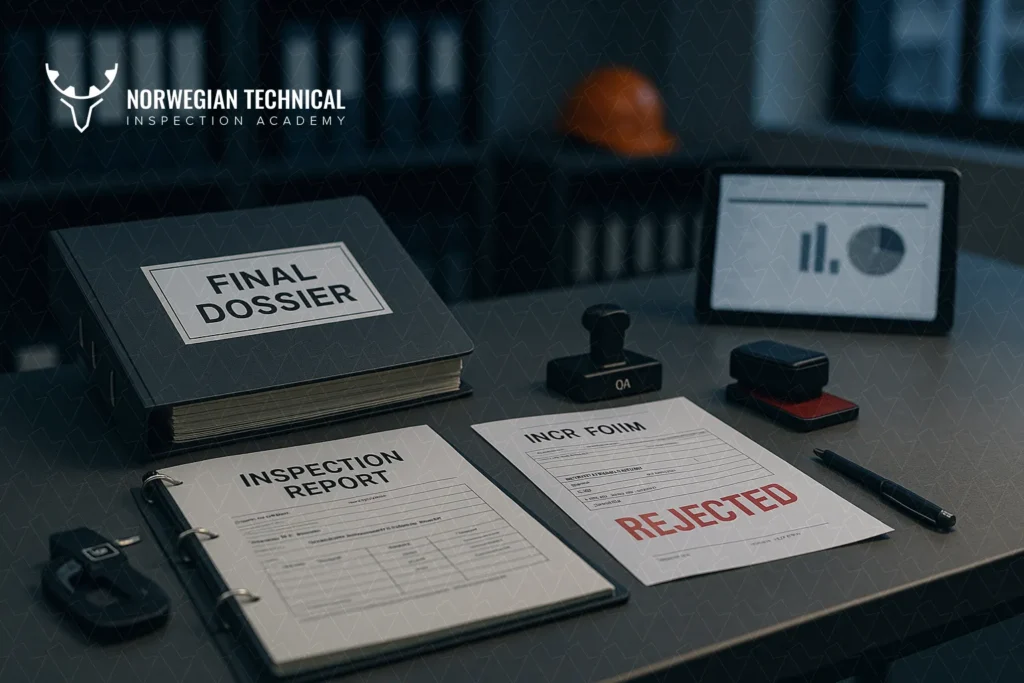

In vendor inspection, reporting is not just paperwork—it is the evidence trail that proves materials and equipment conform to the purchase order, codes, and acceptance criteria. Without proper reporting, inspection activities lose their traceability, and disputes during FAT, delivery, or commissioning become inevitable.
A well-structured Inspection Report (IR), a precise Non-Conformance Report (NCR), and a complete Final Dossier form the backbone of QA/QC documentation in any vendor project. These reports:
👉 If you are new to the topic, start with our guide What Is Vendor Inspection? Roles & Responsibilities to understand the fundamentals before diving into reporting.
The Inspection Report (IR) is the first tangible output of vendor inspection. It records what was inspected, when, and with what result. The IR serves as a factual log, not an opinion—it must reflect exactly what the inspector observed at the supplier’s facility.
👉 Related reading: Vendor Inspection ITP Template (Excel) + How to Use
Although formats differ across companies, most IRs include the following mandatory elements:
📌 For consistency, many organizations adopt formats aligned with ISO 19011 auditing guidelines.
| Section | Example Entry |
| Project Ref / PO | PO-4578 / EPC-210 |
| Vendor | XYZ Valves Co. |
| Item Description | Gate Valve 6” Class 300 |
| Serial / Tag No. | GV-300-006 |
| ITP Ref / Stage | Hydrostatic Test – Witness Point |
| Date / Location | 12 Sept 2025, Vendor Shop – Milan, Italy |
| Inspector | John Smith (NTIA Certified) |
| Findings | Test pressure 45 bar / No leakage observed |
| Attachments | Test certificate, Photos, Calibration cert |
An NCR (Non-Conformance Report) is issued when an inspected item or process does not meet the specified requirements in the Purchase Order, ITP, or referenced codes/standards.
Typical triggers:
| Section | Example Entry |
| Project Ref / PO | PO-4578 / EPC-210 |
| Vendor | XYZ Valves Co. |
| Item Description | Gate Valve 6” Class 300 |
| Non-Conformance | Seat leak test failed at 45 bar – leakage observed |
| Clause Violated | API 598 — Valve Inspection & Test Standard, Clause 7.2 |
| Severity | Major |
| Disposition | Vendor to re-machine seat and re-test under inspector’s witness |
| Corrective Action | Vendor to review machining process and train operators |
| Inspector Signature | John Smith |
| Vendor QC Signature | Eng. Marco Rossi |
The Final Dossier (or “Manufacturing Record Book”) is the complete QA/QC documentation package delivered at project close-out. It proves that all inspections, tests, and certifications were completed and approved.
👉 Related guide: MTC Interpretation Guide + Checklist (PDF)
| Section | Included (✔/✘) | Notes |
| PO & Specs | ✔ | PO-4578 / EPC-210 |
| ITP (signed) | ✔ | Witness points covered |
| MTCs (EN 10204 3.1) | ✔ | Heat no. 98765 / ASTM A105 |
| IRs | ✔ | 12 IRs attached |
| NCRs (closed) | ✔ | 1 NCR closed with re-test |
| Test Certificates | ✔ | Hydrotest, PMI, NDT |
| Calibration Certificates | ✔ | Pressure gauge, UT machine |
| Manufacturer Data Sheets | ✔ | Drawings + datasheets |
| Final Release Note | ✔ | Signed 15 Sept 2025 |
✅ Download IR Template (ZIP)
✅ Download NCR Template (ZIP)
✅ Download Final Dossier Checklist (ZIP)
Mastering IR, NCR, and Final Dossier reporting is not just about filling out forms—it’s about ensuring compliance, preventing costly disputes, and building credibility as a QA/QC professional.
If you want to:
👉 Then join our Vendor Inspection Training Course.
This course is tailored for:
📌 Every participant receives:
Version 2 (Short)
Join NTIA’s Vendor Inspection Training Course.
Master IR, NCR, and Final Dossier reporting with templates, case studies, and certification trusted by EPC contractors.
At NTIA (Norwegian Technical Inspection Academy), we specialize in delivering world-class training programs in vendor inspection, quality surveillance, and technical compliance – specifically tailored for professionals in the oil, gas, and energy industries.
Copyright © 2025 by NTIA. All Rights Reserved.